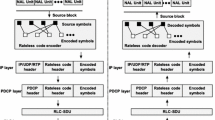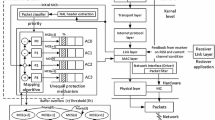Abstract
With the growing popularity of the Internet, there is an increasing demand to deliver continuous media (CM) streams over the Internet. However, packets may be damaged or lost during transmission over the current Internet. In particular, periodic network overloads often result in bursty packet losses, degrading the perceptual quality of CM streaming. In this paper, we focus on reducing the impact of this bursty loss behavior. We propose a novel robust end-to-end transmission scheme, referred to as packet permutation (PP), to deliver pre-compressed continuous media streams over the Internet. At the server side, PP permutes, prior to transmission, the normal packet delivery sequence of CM streams in a specific way. The packets are then re-permuted at the receiver side before they are presented to the application. In this way, the probability of losing a large number of packets within each CM frame can be significantly reduced. To validate the effectiveness of PP, a series of trace-driven simulations are conducted. Our results show that for a given quality of service (QoS) requirement of CM streaming, PP greatly reduces the overhead required by traditional error control schemes, such as forward error correction (FEC) and feedback/retransmission-based schemes.
Similar content being viewed by others
References
J.C. Bolot, T. Turletti, and I. Wakeman, “Scalable feedback control for multicast video distribution in the Internet,” in Proc. ACM SIGCOMM'94, London, UK, 1994, pp. 58–67.
J.C. Bolot and A.V. Garcia, “The case for FEC-based error control for packet audio in the Internet,” ACM Multimedia Systems, in press.
J.C. Bolot and T. Turletti, “Experience with rate control mechanisms for packet video in the Internet,” Computer Communication Review, Vol. 28, No. 1, 1998.
J.C. Bolot, S. Fosse-Parisis, and D. Towsley, “Adaptive FEC-based error control for Internet telephony,” in Proc. IEEE Infocom'99, 1999, pp. 1453–1460.
D. Clark and D. Tenenhouse, “Architectural considerations for a new generation of protocols,” in Proc. ACM SIGCOMM'90, 1990, pp. 200–208.
D. Comer, Internetworking with TCP/IP, Principles, Protocols, and Architecture, Vol. I. Prentice Hall: Englewood Cliffs, NJ, 1995.
J.W. Ding and Y.M. Huang, “An efficient striping strategy for video servers using heterogeneous disksubsystems,” Multimedia Tools and Applications, Vol. 18, No. 2, 2002.
S. Floyd and V. Jacobson, “Random early detection gateways for congestion avoidance,” IEEE/ACM Trans. on Networking, Vol. 14, pp. 397–413, 1993.
B. Furth, S.W. Smoliar, and H. Zhang, Video and Image Processing in Multimedia Systems, Kluwer Academic Publishers: Norwell, MA, 1995.
H. Ghanbari and V. Seferidis, “Cell loss concealment in ATM video codecs,” IEEE Trans. on Circuits Systs. Video Tech., Vol. 3, No. 3, pp. 238–247, 1993.
Y.M. Huang, J.W. Ding, and S.L. Tsao, “Constant time permutation: An efficient block allocation strategy for variable bit rate continuous media data,” The VLDB Journal, Vol. 8, No. 1, pp. 44–54, 1999.
F. Kuo, W. Effelsberg, and J.J. Garcia-Luna-Aceves, Multimedia Communications, Prentice Hall: PTR, 1998.
U. Manber, Introduction to Algorithms: A Creative Approach, Addison-Wesley, 1989.
A.J. McAuley, “Reliable broadband communication using a burst erasure correcting code,” in Proc. ACM SIGCOMM'90, Philadelphia, PA, USA, 1990, pp. 297–306.
D.E. McDysan and D.L. Spohn, ATM: Theory and Application, McGraw-Hill, Inc., 1995.
C. Metz, “IP QoS: Traveling in first class on the Internet,” IEEE Internet Computing, pp. 84–88, Mar. 1999.
H.Q. Ngo, S. Varadarajan, and J. Srivastava, “Error spreading: Reducing bursty errors in continuous media streaming,” in Proc. IEEE Int. Conf. on Multimedia Computing and Systems, 1999, pp. 314–319.
J. Nonnenmacher, E. Biersack, and D. Towsley, “Parity-based loss recovery for reliable multicast transmission,” in Proc. ACM SIGCOMM'97, Cannes, France, 1997, pp. 289–300.
J. Padhye, V. Firoiu, D. Towsley, and J. Kurose, “Modeling TCP throughput: A simple model and its empirical evaluation,” in Proc. ACM SIGCOMM '98, Vancouver, CA, 1998.
V. Paxson, “End-to-End Internet packet dynamics,” in Proc. ACM SIGCOMM'97, Cannes, France, 1997.
C. Perkins, “RTP payload format for interleaved media,” IETF Audio/Video TransportWorking Group, IETF draft: draft-ietf-avt-interleaving-00.txt, Nov. 1998.
J. Postel, “The TCP maximum segment size and related topics,” RFC 879, Internet Engineering Task Force, Nov. 1983.
S. Ramanathan and P.V. Rangan, “Feedback techniques for intra-media continuality and Inter-Media synchronization in distributed multimedia systems,” The Computer Journal, Vol. 36, No. 1, pp. 19–33, 1993.
L. Rizzo, “Effective erasure codes for reliable computer communication protocols,” Computer Communication Review, April 1997.
T.L. Sheu and J.T. Fang, “A buffer allocation mechanism for VBR video playback,” in Proc. IEEE Int. Conf. on Communication Technology, Beijing, China, 2000, Vol. 2, pp. 1641–1644.
B.C. Smith, “Implementation techniques for continuous media systems and applications,” Ph.D. Thesis, University of California, Berkeley, 1994.
D. Sitaram and A. Dan, Multimedia Servers, Morgan Kaufmann Publishers: San Francisco, CA, 2000.
W. Stevens, TCP/IP Illustrated, The Protocols, Vol. 1, Addison-Wesley: Reading, MA, 1994.
S.A. Thomas, IPng and the TCP/IP Protocols, Wiley Computer Publishing, 1996.
S. Varadarajan, H.Q. Ngo, and J. Srivastava, “An adaptive, perception-driven error spreading scheme in continuous media streaming,” in Proc. ICDCS'2000, Taipei, Taiwan, 2000, pp. 475–483.
S. Varadarajan, H.Q. Ngo, and J. Srivastava, “Error spreading: A perception-driven approach orthogonal to error handling in continuous media streaming,” IEEE/ACMTrans. on Networking, Vol. 10, No. 1, pp. 139–152, 2002.
H. Wang and K.G. Shin, “Refined design of random early detection gateways,” in Proc. IEEEGLOBECOM'99, Dec. 1999, Vol. 1, pp. 769–775.
M. Yajnik, S. Moon, J. Kurose, and D. Towsley, “Measurement and modeling of the temporal dependence in packet loss,” in Proc. IEEE INFOCOM'99, 1999, Vol. 1, pp. 345–352.
Q.-F. Zhu et al., “Coding and cell loss recovery in DCT-based packet video,” IEEE Trans. Circuits Systems. Video Tech., Vol. 3, No. 3, pp. 248–258, 1993.
Author information
Authors and Affiliations
Rights and permissions
About this article
Cite this article
Ding, JW., Tseng, SY. & Huang, YM. Packet Permutation: A Robust Transmission Technique for Continuous Media Streaming Over the Internet. Multimedia Tools and Applications 21, 281–305 (2003). https://doi.org/10.1023/A:1025727002272
Issue Date:
DOI: https://doi.org/10.1023/A:1025727002272




